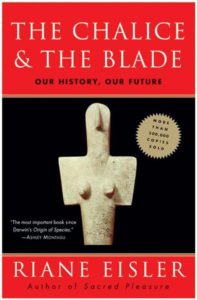
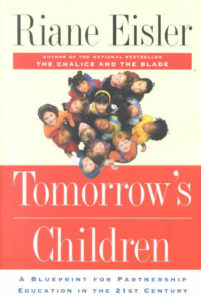
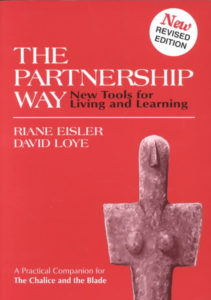
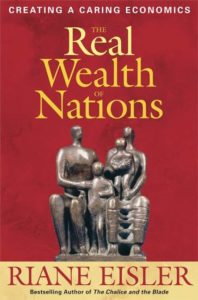


CULTURAL TRANSFORMATION THEORY
Many believe that the current state of the world, filled with turmoil and strife, is inevitable and a normal part of the human condition. The horrors of war, mass destruction, social injustice, violence and abuse, poverty and hunger, and degradation of our natural environment all seem overwhelming and ever-present, and cause so many of us to feel spiritually bereft with little hope.
However, a number of scholars claim that human culture has not always been this way.
1. Also, visionary social thinkers and activists have confidence that we can create a better future.
2. In her groundbreaking book, The Chalice and the Blade, Riane Eisler (1987) drew upon research in fields such as archaeology, myth, archaeomythology, art history, religion, and history (including pre- and protohistory) to describe a past in which societies enjoyed greater gender parity and were more harmonious, with little or no evidence of warfare. In these societies, social relations were based on a principle of linking disparate group members in an egalitarian system, with mutual regard, respect, and care as a foundation of interactions (Eisler, 1987, 2002). These were societies oriented toward what Eisler termed "partnership." While the partnership model involves some hierarchy, since social organization is not entirely flat, relationships and leadership empower group members toward greater functioning in hierarchies of actualization (Eisler, 2002, p. 212). ___________________________________________________________________________
1 A number of scholars put forward that social organization and women's roles in society were not always as they are today, and point to the possibilities of more egalitarian and matristic-oriented societies in the past. See for example: Eisler, 1987, 2002, 2008; Carter, 2009; Marler, 1997, 2005, 2009, 2011; Haarmann, 2013, 2014; Sanday, 1981, 2003; Gimbutas, 1974, 1989, 1991; Ehrenberg, 1989; Mellaart, 1967.
2 See for example: Eisler, 1987, 2002, 2008; Macy, 1991, 2007, 2012, 2014; Wheatley, 2009, 2011, Göttner-Abendroth, 1988, 1991, 2000
http://pubs.lib.umn.edu/ijps/vol1/iss1/7 2
______________________________________________________________________
Partnership, according to Eisler, was the direction of our cultural evolution in ancient times.
At some point this all changed. Eisler (1987) posits:
Following a period of chaos and almost total cultural disruption, there occurred a fundamental shift. The greater availability of data on Western societies (due to the ethnocentric focus of Western social science) makes it possible to document this shift in more detail through the analysis of Western cultural evolution. (p. xvii)
However, we now know that this shift was paralleled in other parts of the world (Chinese Partnership Research Group, 1995; Carter, 2009).
A shift in the direction of cultural evolution toward what Eisler termed the "domination" model resulted in a ranking system that privileged males and resulted in positioning half of humanity over the other half: male over female. This set the stage for growing inequities and greater social stratification, with groups designated as “superior” dominating those groups designated as "inferior." To maintain this authoritarian model and its strict hierarchies of domination, the use of fear tactics and force, along with socially accepted violence—even valorized violence—was required.
Eisler's (1987) development of the domination and partnership models reexamined human society "from a gender-holistic perspective" and resulted in "a new theory of cultural evolution" (p. xvii), which she called Cultural Transformation Theory. Cultural Transformation Theory "contradicts the conventional notion of a linear progression from 'barbarism' to 'civilization'" and claims that ancient civilization was oriented toward partnership (Center for Partnership Studies, n.d.).
While it is true that a more peaceful past is no guarantee of a more peaceful future, the vision of such a past does provide an example of what is possible. It allows us to envision something different than what is in place today, and then to work toward it. Thus, we can renew hope, imagine better options, and work toward the possibilities of a more just, caring, partnership-oriented world.
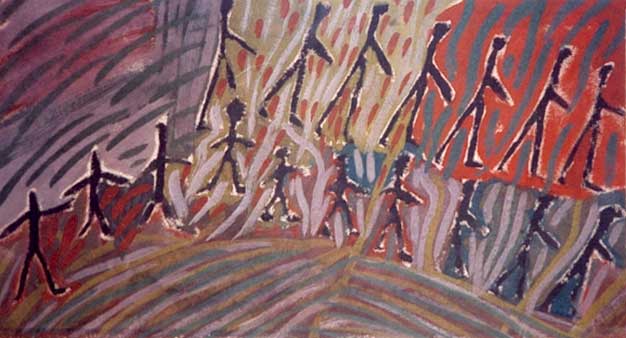
THE DOMINATION /PARTNERSHIP CONTINUUM
In her book The Power of Partnership: Seven Relationships That Will Change Your Life, Eisler (2002) built on her Cultural Transformation Theory to develop a fuller picture of the domination/partnership models and how they are manifested in today's world. Eisler has been persistent in pointing out that no social system exists entirely at one or the other end of the spectrum; rather, these models work on a continuum. Because human societies are a mix of both partnership-oriented elements and domination-oriented elements, they are not fixed, and at any given time might be situated differently on this domination/partnership continuum. With this in mind, and with the overall goal of working toward greater partnership, she has provided examples and a model, including a set of practical steps to help catalyze and sustain the personal and cultural transformation so vitally needed to address our world's problems today.
THE POWER OF PARTNERSHIP INM CURRICULA
The Power of Partnership (Eisler, 2002) is organized in a way that makes it an excellent primary text and basis for discussion in the classroom. Eisler explores seven universal relationships we all have in our lives, with a chapter devoted to each:
• Your Relationship with Yourself: Body, Mind, and Spirit
• Your Intimate Relations: The Heart of the Matter
• Your Work and Community Relationships: The Widening Circle of Caring
• Your Relationship with your National Community: Why Politics Matter
• Your Relationship with the International Community: The World Around Us
• Your Relationship with Nature: From Mother Earth to Biotechnology
• Your Spiritual Relations: Putting Love Into Action
In each chapter, Eisler discusses the importance of the particular relationship of focus, and provides examples of how partnership and domination may manifest within it. At the end of each chapter is a checklist of suggested action steps.
The book contains additional partnership tools at the end, in addition to a logical progression of real-life examples of the relationships or elements in partnership. The organization of the text into eight chapters makes this book ideal for a one-term class of 10 weeks. To expand the course to a 15-week semester, or to further augment the conversation, other reading and activity assignments can be added according to the length and focus of the course and student interests.
The examples shared in the book are often familiar, such as pay inequities and intimate violence, and sometimes surprising or alarming, such as continuation of bride burnings and female genital mutilation.
While the book was written over a decade ago, the material remains relevant because so many of our societal woes persist. The names or specific circumstances may change, but the ways in which partnership can serve as a catalyst and support for social change are as applicable as ever. Daily news items and ongoing world affairs provide up-to-the-minute examples that are readily available for use in the classroom. In addition, examples of partnership-oriented organizations can be researched to demonstrate the applicability and versatility of these ideas and to determine the longevity of their successful use in both the for-profit and not-for- profit sectors.
It is obvious to most people involved in Partnership Studies that the concept of partnership is simple. However, as is often the case with transformative education, it is the implementation of these ideas—day by day, and over time—wherein the true challenges reside!
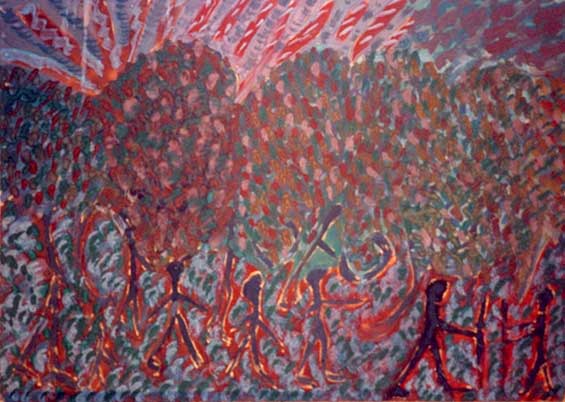
Artwork by Issa »
PARTNERSHIP ACTIVITIES AND PROJECTS
As already mentioned, one of the strengths of partnership work is that one can approach this model in many different ways and in multiple areas of one's life and work. It is possible to explore and apply the partnership model intermittently and in sections, both for personal growth and to make a difference in one's communities. It is also possible to apply academic rigor in an interdisciplinary manner, with interesting and inspiring results. The idea is to begin, even in small ways. Eisler (2002) reminds us, "This doesn't mean that every one of us has to do everything. But wherever we are and whenever we can, every one of us can do something to move us from domination to partnership" (p. xxi).
Examples of activities to assign to further partnership understanding and application:
After reading each chapter in The Power of Partnership, choose one or two action steps to undertake in the coming week (and beyond). Journal about your experiences and/or share with the class (online or in a class meeting as assigned).
• Looking in the media, find examples of the domination model and the partnership model. Comment on these and share with the class (online or in a class meeting as assigned).
• Go to the Center for Partnership Studies website (www.partnershipway.org) or to Riane Eisler's website (www.rianeeisler.com) to see what resources are available there. Choose 2-4 resources (videos, articles, and so on); summarize and compare them in a short report.
Reach out to a family member, friend, or colleague, and explain your developing understanding of the domination and partnership models. Engage in discussion and conversation.
Be aware of the use of language and note how many terms perpetuate domination orientation.Think of alternative terms that further partnership orientation, and make a conscious effort to use them in conversation.
In transformative education, students often take learning materials deeper and apply them more broadly when they develop a meaningful topic and application for academic work of their own choosing.
Partnership Studies in curricula allow for flexibility and student choice in final projects. In nearly a decade of teaching
partnership in several universities at both the undergraduate and graduate levels, I have been privileged to witness exciting projects undertaken by students on a wide variety of topics and with impressive results.3
Focus on partnership with self and intimate others (and beyond):
• Examine a difficult event or relationship in your life, apply the partnership model to it, and create a plan for change.
• Engage your children in the creation of partnership activities and projects the family can enjoy together; document them and note any resulting changes in family relations and other relationships.
• Create a blog on partnership with friends and family (password protected) to learn about partnership together.
• Draft a "conscious consumer spreadsheet" to track consumption in your household; emphasize using resources and companies that are partnership- oriented.
• Develop a handbook of intercultural respect in intimate relations to study intercultural couples through the lens of Eisler's Four Cornerstones.4 Provide discussion questions and activities to help heighten awareness of the partnership/domination continuum and how it applies to relationships.
Focus on partnership in one's community (and beyond):
• Write a manual/workshop guide for groups that want to start partnership communities.
3 Some of these examples were previously included in the following publication: Eisler, R., & Carter, S. (2010). Transformative leadership: From domination to partnership. Revision: A Journal of Consciousness and Transformation, 30(3/4), 104-112.
4 The four cornerstones as described by Eisler serve as a foundation on which to build a more partnership-oriented society, and include childhood relations, gender relations, economic relations, and stories, beliefs, and spirituality. To read a short article written by Riane Eisler about these cornerstones see "Building a Just and Caring World: Four Cornerstones" (full URL/access information can be found in References). For more information see The Center for Partnership Studies website: http://www.partnershipway.org
• Develop a multi-media presentation for young men about partnership systems.
• Develop a partnership audit to assess and improve the policies and practices of a major U.S. city. (Implementing the recommendations of such an audit can
become a goal for a number of civil society groups.)
• Develop and host blogtalk radio shows that include guests who speak on
partnership and related themes.5
• Create a blog about intercultural experience and partnership.
Focus on partnership with nature (circling back to community and self):
• Develop a rite-of-passage program in nature for young people based on partnership with nature and partnership with self and community.
• Develop a workshop integrating partnership elements with the practice of Yoga (that includes a focus on unity—connection with nature, self, and others).
• Make the connection between bullying and lack of connection with nature and develop a curriculum to increase this connection for healing trauma in youth.
Focus on partnership with spirit (our stories, myths, and beliefs):
• Rewrite a myth or fairy tale to remove misogynistic or violent strands so that it is more partnership-oriented.
• Look at themes in movies or stories that demonstrate partnership, but which have not been previously analyzed with the application of a partnership lens, in order to bring greater awareness to partnership-oriented literature or film.
5 See the following examples on "The Cathy Bennett Show" on Blogtalk Radio (full URLs/access information can be found in References): "What has a Hold on You? Domination or Partnership? – with Riane Eisler and Susan Carter" (March 14, 2012); "The Economics of Partnerism: The Real Wealth of Nations – with Riane Eisler and Susan Carter" (Oct. 3, 2012); and "Caring Economy Leadership Program: Small but far reaching" – with Susan Carter and Sara Saltee (Aug. 28, 2013).
Produced by University of Minnesota Libraries Publishing, 2014 9
Interdisciplinary Journal of Partnership Studies, Vol. 1 [2014], Iss. 1, Art. 7
Finally, here are examples of capstone, thesis, and dissertation work directly informed by Partnership Studies:
• A thesis student applied the partnership framework to a specific Andean population who practiced deep reciprocity and with whom she lived for a number of years.
• A doctoral student, who founded a children's camp focused on healing for survivors of abuse, documented stories from 20 years of the organization's operation through a partnership lens to provide a template for others.
• A doctoral student working in the field of medicine looked to partnership systems for ways in which partnership can positively impact patient care outcomes and improve nurse satisfaction in a time of dire nursing shortages.6
As Riane Eisler (2002) states, "Change involves two things: awareness and action" (p. xix). Integrating Partnership Studies into transformative educational curricula offers rich opportunities for both—awareness (learning) and action (application)—often with exponential results.
6 This dissertation project grew and several years later was developed into the book, Transforming Interprofessional Partnerships: A New Framework for Nursing and Partnership-based Healthcare. (Eisler, R., & Potter, T. M. (2014). Transforming interprofessional partnerships: A new framework for nursing and partnership-based healthcare. Sigma Theta Tau International.)
http://pubs.lib.umn.edu/ijps/vol1/iss1/7 10

Artwork by Issa »
REFERENCES
Bennett, C. (Host and Producer). (2012, March 14). What has a hold on you? Domination or partnership? – with Riane Eisler and Susan Carter [Blogtalk Radio file]. Retrieved from http://www.blogtalkradio.com/cathybennett/ 2012/03/14/the-power-of-partnership-during-critical-times
Bennett, C. (Host and Producer). (2012, October 3). The economics of partnerism: The real wealth of nations – with Riane Eisler and Susan
Carter [Blogtalk Radio file]. Retrieved from http://www.blogtalkradio.com/cathybennett/2012/10/03/the-economics-of- partnerism-the-real-wealth-of-nations
Bennett, C. (Host and Producer). (2013, August 28). Caring economy leadership program: Small but far reaching – with Susan Carter and
Sara Saltee [Blogtalk Radio file]. Retrieved from http://www.blogtalkradio.com/cathybennett/ 2013/08/28/caring-economy-leadership-program-small-but-far-reaching
Carter, S. (2009). The matristic roots of Japan and the emergence of the Japanese sun goddess, Amaterasu-o-mi-kami. In H. Goettner-
Abendroth (Ed.), Societies of peace: Matriarchies past, present, and future (pp. 394-404). Toronto, Canada: Inanna Publications.
Center for Partnership Studies. (n.d.). Cultural transformation theory. In Foundational Concepts. Retrieved from: http://www.partnershipway.org/about- cps/foundational-concepts/cultural-transformation
Chinese Partnership Research Group at the Chinese Academy of Social Sciences in Beijing. (1995). (M. Jiayin, Ed.). The chalice and the blade in Chinese culture: Gender relations and social models. Beijing, China:
China Social Sciences (distributed by HarperCollins).
Ehrenberg, M. Women in prehistory. (1989). Norman, OK and London: University of Oklahoma Press.
Eisler, R. (1987). The chalice and the blade: Our history, our future. San Francisco, CA: HarperSanFrancisco.
Produced by University of Minnesota Libraries Publishing, 2014 11
Interdisciplinary Journal of Partnership Studies, Vol. 1 [2014], Iss. 1, Art. 7
Eisler, R. (1998, 2005). Building a just and caring world: Four cornerstones. Retrieved from http://www.partnershipway.org/learn-more/articles-by-riane- eisler/partnership-culture/building-a-just-and-caring-world-four- cornerstones/?searchterm=Four%20Cornerstones
Eisler, R. (2002). The power of partnership: Seven relationships that will change your life. Novato, CA: New World Library.
Eisler, R., & Carter, S. (2010). Transformative leadership: From domination to partnership. Revision: A Journal of Consciousness and Transformation, 30(3/4), 104-112.
Eisler, R., & Potter, T. M. (2014).Transforming interprofessional partnerships: A newframework for nursing and partnership-based healthcare. Indianapolis, IN: Sigma Theta Tau International.
Gimbutas, M. (1974, 1982, 1992). The goddesses and gods of Old Europe. London: Thames & Hudson.
Gimbutas, M. (1989). The language of the goddess. San Francisco, CA: Harper & Row. Gimbutas, M. (1991). The civilization of the goddess: The world of Old Europe. San
Francisco, CA: HarperSanFrancisco.
Haarman, H. (2014). Roots of ancient Greek civilization: The influence of Old Europe.Jefferson, NC: McFarland.
Haarman, H. (2013). Ancient knowledge, ancient know-how, ancient reasoning: Cultural memory in transition from prehistory to classical antiquity and beyond. Amherst, NY: Cambria Press.
Macy, J. (1991, 2007). World as lover, world as self: Courage for global justice and ecological renewal. Berkeley, CA: Parallax Press.
Macy, J., & Brown, M. Y. (2014). Coming back to life: The updated guide to the work that reconnects. Gabriola Island, Canada: New Society Publishers.
Macy, J., & Johnstone, C. (2012). Active hope: How to face the mess we're in without going crazy. Novato, CA: New World Library.
Marler, J. (2011). Warfare in the Neolithic? An examination the evidence. Journal of Archaeomythology 7, 52-64. http://www.archaeomythology.org/journal/
http://pubs.lib.umn.edu/ijps/vol1/iss1/7 12
Carter: Partnership Studies in Transformative Education
Marler, J. (2009). The iconography and social structure of Old Europe: The archaeo- mythological research of Marija Gimbutas. In H.
Goettner-Abendroth (Ed.), Societies of peace: Matriarchies past, present, and future (pp. 283-296). Toronto, Canada: Inanna Publications.
Marler, J. (2005). The beginnings of patriarchy in Europe: Reflections on the kurgan theory of Marija Gimbutas. In C. Biaggi (Ed.), The rule of Mars: Readings on the origins, history and impact of patriarchy (pp. 53-76). Manchester, CT: Knowledge, Ideas & Trends (KIT).
Marler, J. (Ed). (1997). The realm of the ancestors: An anthology in honor of Marija Gimbutas. Manchester, CT: Knowledge, Ideas & Trends (KIT).
Mellaart, J. (1967). Catal Huyuk: A Neolithic town in Anatolia. New York: McGraw-Hill Book Company.
Sanday, P. R. (1981). Female power and male dominance: On the origins of sexual inequality. Cambridge: University of Cambridge Press.
Sanday, P. R. (2003). Women at the center: Life in a modern matriarchy. Ithaca, NY: Cornell University Press.
Wheatley, M. (2009). Turning to one another: Simple conversations to restore hope to the future. San Francisco, CA: Berrett-Koehler Publishers, Inc.
Wheatley, M., & Frieze, D. (2011). Walk out walk on: A learning journey into communities daring to live the future now. San Francisco, CA:
Berrett- Koehler Publishers, Inc.
Susan G. Carter, Ph.D., is a consultant to The Center for Partnership Studies, and has been teaching partnership for many years. She regularly co-teaches the “The Power of Partnership” with Riane Eisler, an online course they designed and developed together for the Transformative Leadership Master’s and Transformative Studies Ph.D. Programs Partnership Studies focus at the California Institute of Integral Studies (CIIS), San Francisco, CA. She also teaches "Partnership: A Model for Personal and Cultural Transformation" at Marylhurst University, in the Master's of Arts in Interdisciplinary Studies program (for which she serves as Chair) and the Human Sciences department.
As a feminist scholar and an avid advocate of volunteerism and community-based learning, Susan is actively involved in the non-profit sector, and has served on a number of boards that promote education and empowerment of underserved populations, cross-cultural understanding, and the arts. She has formed and directed a 501[c][3] foundation, and consults with California Bay Area and Pacific Northwest educational institutions to help promote community service. In addition, she presents nationally and internationally on diverse educational, partnership, cultural and spiritual topics.
Susan Carter holds an M.A. in Women’s Spirituality and a Ph.D. in Humanities (Philosophy and Religion) from The California Institute of Integral Studies (CIIS), San Francisco, CA.
Correspondence about this article should be directed to Susan Carter, Ph.D., at susangailcarter@yahoo.com
http://pubs.lib.umn.edu/ijps/vol1/iss1/7